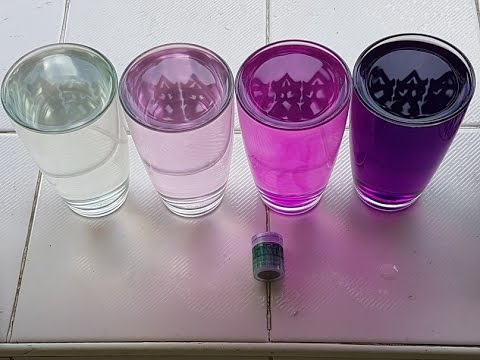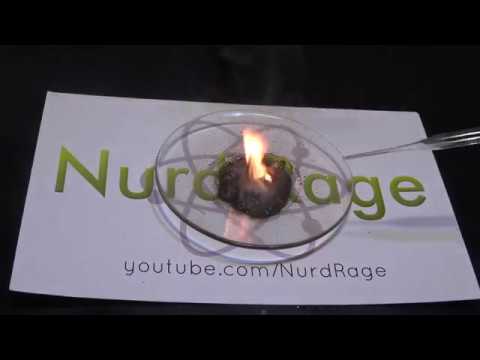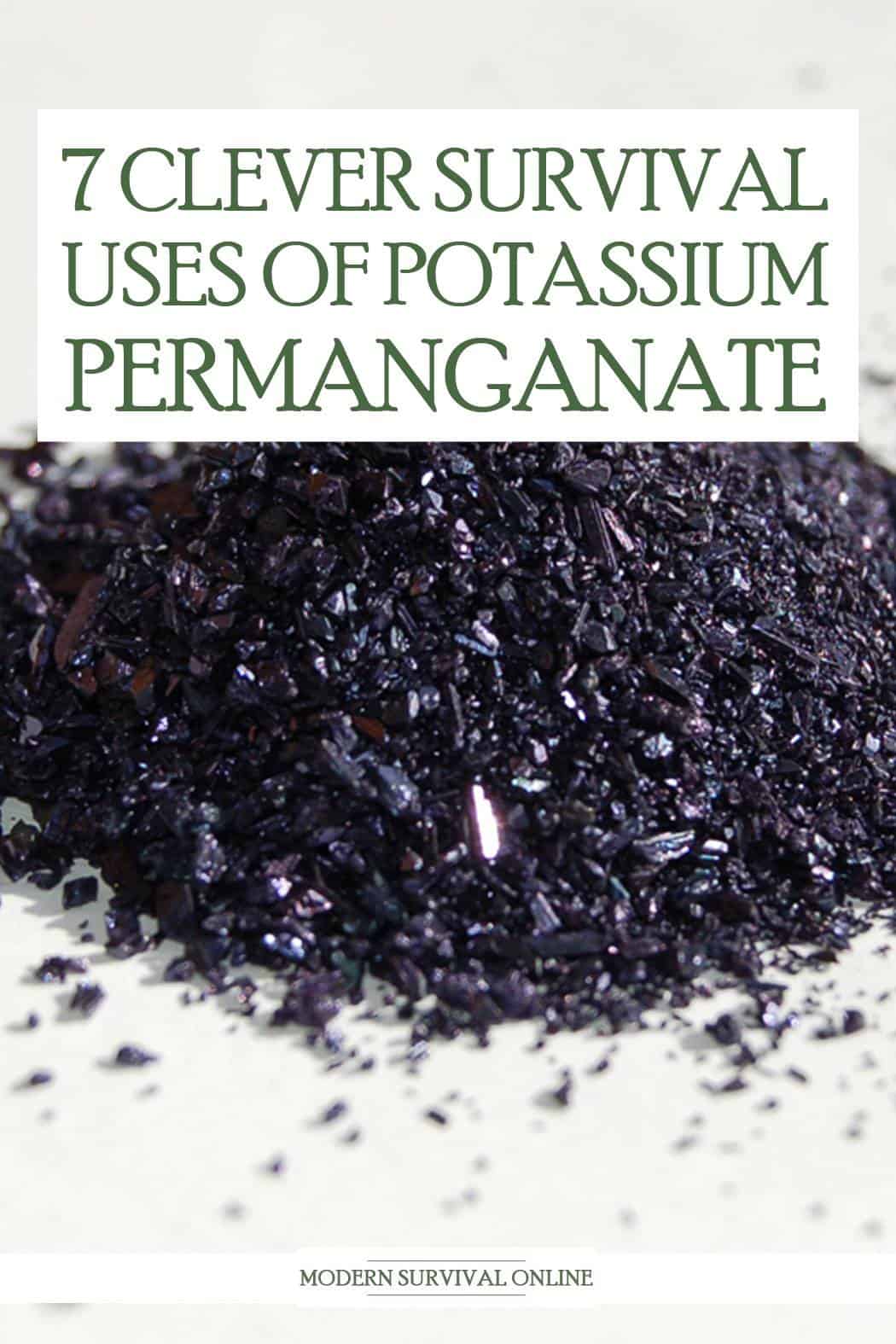Savvy prepping means being prepared for anything, and since time, resources and materials are always limited clever preppers will rely on choice gear and provision selections that can be used for a variety of purposes, or adaptable to different situations.
Flexibility is key when you never know just what you’ll be facing day to day. Some foundational knowledge of simple chemistry can allow a person to make use of common, affordable chemical compounds for a variety of purposes in the field, at home and in the workshop.
One standout compound that all preppers should familiarize them themselves with is potassium permanganate, a compound that sees wide use in all sorts of industrial and scientific settings for a variety of purposes.
Its antiseptic properties are renowned, as are its high reactivity and strong oxidizing qualities. Despite these characteristics, it rarely produces toxic byproducts when it does react with anything, allowing us to employ it safely for our own purposes.
Potassium permanganate is one compound you will definitely want in your survival stash, and to help get you prepared for making the most of this shockingly purple chemical we will be sharing with you a list of seven clever survival uses for it. Grab your goggles and your lab gloves and let’s get going.
What is Potassium Permanganate and Where does it Come From?
Potassium permanganate is an inorganic chemical compound, widely used in laboratory and chemical industry settings. It is useful because it is a strong oxidizer and also has potent antiseptic qualities.
It appears as a crystal, similar in size and shape to coarse salt, but has a startling, deep purple color. When dissolved in water, the resulting solution will appear anywhere from almost black, to royal purple to light pink depending on concentration.
Despite its strong oxidizing characteristics, it does not generate any toxic byproducts, and this lends it to medicinal use as well as specialty uses in the production or refinement of other chemicals.
In fact, it is so useful in medicinal settings it is on the World Health Organization’s list of essential medicines, medicines which are rated as among the most effective and the safest, needed in any health setting.
Potassium permanganate is typically produced at the industrial level from manganese dioxide, naturally occurring as pyrolucite. It is also capable of being oxidized from chlorine under certain conditions, although this method has no commercial relevance compared to more typical methods of production.
Although easy enough to create the production of potassium permanganate worldwide ranges anywhere from 25,000 to 33,000 tons.
Although it is generally safe as far as strong oxidizers go contact with skin will leave a brown stain that is both persistent and extremely dark, so don’t get any on you.
Again, it is this quality as a strong oxidizer that makes potassium permanganate useful, and that includes useful at an individual level so long as you use a little caution in handling and preparation. That’s enough for the safety lesson, let’s get to our list.

Safe Handling Guidelines for Potassium Permanganate
Before we get to the fun part of learning what potassium permanganate can do for you, we need to have a short safety brief. Though overwhelmingly safe compared to many chemicals out in the world you might encounter, this stuff can still definitely hurt you if you aren’t paying attention or are ignorant to the dangerous conditions it can create.
In short, potassium permanganate poses a hazard if it is inhaled, ingested (in high concentrations), makes contact with your eyes or remains on your skin. It is an oxidizer, and corrosive, and though it is not as corrosive as many acids it is more than capable of harming you.
Exposure Symptoms and Effects:
- Inhalation; sore throat, irritation of respiratory tract, irritation of mucous membranes. High concentrations can make breathing difficult. Long term health risk of lung edema.
- Skin Contact; Irritation, tingling sensation, brown staining. Prolonged contact causes burns and corrosion of tissue.
- Eye Contact; Inflammation of eye tissue, corrosion of eye tissue. Prolonged contact causes permanent eye damage.
- Ingestion; Nausea, vomiting diarrhea likely. Irritation of stomach and intestinal mucosa. Ingestion of large quantities may cause esophageal perforation, shock, slow heartbeat, lowered blood pressure, respiratory difficulties and laryngeal spasms.
Treatment and First-Aid Measures: Treatment of the above symptoms is fairly simple, though you should always seek immediate medical care and contact poison control specialists if in doubt. For skin and eye contact, remove all clothing and eyewear/contact lenses before flushing with water continuously for at least 15 minutes.
If clothing or contacts cannot be removed due not remove by force. Inhalation should see the victim moved to fresh air away from the exposure site. Monitor for breathing difficulties. If ingested, give victim large quantities of fresh water to drink. Do not induce vomiting.
At no time should any neutralizing agents be administered topically or orally in case of potassium permanganate exposure! Water is all that is required!
Protective Measures: Gloves and face shield for handling of typical, crystalline form. If dust hazard exists respiratory protection must be used. Atmospheric reactivity hazards mandate use of gas-tight suit. See SDS for more info.
7 Clever Uses of Potassium Permanganate
General Disinfectant Solution
Potassium permanganate solution made with water forms an excellent general purpose disinfectant, and is also particularly hostile to cholera. It can be used for cleaning surfaces, rinsing out wounds and any other task where cleansing germs is a goal.
Considering the potassium permanganate crystals may be of varying sizes and varying quality calculating exactly how much you should or should not add to a given quantity of water to produce a disinfectant solution of a particular strength is challenging.
Luckily, we have a “prepper friendly” method that is easy enough to do even in austere environments without measuring tools. All you need to do is add potassium permanganate crystals, one by one, carefully, to a given quantity of water before stirring and agitating the water.
You should notice the water darkening, starting out a pale pink or rose color before progressing through proper pink and into purple. When your solution turns properly purple, it is ready to be used as a disinfectant.
Take care, because as you might have guessed anything you use potassium permanganate on that is stainable will be stained the same, purple color!
Fungicide
Potassium permanganate solution is highly hostile towards a wide variety of fungi, and works well as a soak or topical application for curing fungal infections of the hands and feet, or ridding soft gear of fungal infestation.
To accomplish this, you’ll follow the same procedure that you did for creating a general disinfectant solution, adding potassium permanganate crystals one by one to your quantity of water and stirring until the water turns purple.
Then all you need to do is immerse your hands or feet in the solution for up to 10 minutes, or even longer if no discomfort is felt. Repeated treatments should eventually eradicate all but the most persistent of fungal infestations.
I do have some bad news though, as your hands and feet will definitely be stained purple or turn a brownish color from the process. That’s a small price to pay for ridding yourself of a nasty infection, though, eh?
Against Persistent Skin Infections
The same qualities that make potassium permanganate so effective as a disinfectant and fungicide make it helpful for treating persistent skin infections like dermatitis, pemphigus and impetigo along with a variety of ulcers.
It can help treat these conditions by attacking the underlying bacteriological and virological agitators responsible.
Once again, a solution of potassium permanganate is what is called for, though one not quite as strong as the purple variation we used for general disinfection and fungal eradication.
Add the crystals to your water one by one while stirring, same as before, only you should stop when the solution reaches a dark pink/magenta or light purple color. Then mop the solution onto the affected area before applying a compress wetted with the solution and holding it in place.
Once again a 10 to 20 minute application should be done for starters, no more than a couple of times a day. Stop and assess the situation if any significant discomfort or worsening of the condition results.
Water Purification
Potassium permanganate has many applications when it comes to the treatment of water supplies in various settings and also water purification for drinking.
However, this must be done with particular attention paid to utilizing the correct ratios because too high a concentration of potassium permanganate in drinking water can become toxic very quickly.

Potassium permanganate is effective at killing many bacteria even in low concentrations but higher concentrations must be used to reliably kill viruses. This can make it a dodgy proposition, as total microbiological control can start encroaching on the “danger zone”, but nonetheless one that is viable and sees use all around the world today.
According to our methodology above, potassium permanganate crystals should be added to the sourced water after it has been filtered as best you can manage.
Once again add the crystals one at a time until the water barely turns pink, no more, and then give it 30 minutes to work before drinking. If viruses are a particular concern add one more crystal and then stir before giving it another 30 minutes.
For larger quantities of water or better efficacy in use careful measuring and metering of application should be employed. See the provided link for more information.
Potassium permanganate is also useful for removing iron and hydrogen sulfide from natural water sources, particularly well water. This improves taste, and also most notably gets rid of that nasty, sulfurous smell that is sometimes present.
Fruit and Veggie Wash
Potassium permanganate solution is an excellent disinfectant, as we have learned, but it is surprisingly effective at eliminating cholera, a nasty bug that is often contracted when eating contaminated food.
For this reason potassium permanganate is especially well suited to use as a fruit and vegetable wash to increase food safety. A follow-up rinse with fresh water will eliminate any residue from the solution and then the food will be ready to eat or prepare.
You’ll prepare the solution just like you always do, one crystal at a time, and this time you are gunning for a light to medium purple color.
Take a clean cloth, dip it in the solution and then wipe the fruit or veggies in question down fastidiously or alternately you can immerse them in the solution before shaking them off, and leaving them to sit for a few minutes prior to rinsing with fresh water.
It’s just that easy, and you won’t have to worry about any nasty germs on your fruit and veggies. Also, fun fact, potassium permanganate effectively neutralizes the production of ethylene by bananas, a compound that is released by the bananas as they ripen. Eliminating or otherwise neutralizing this chemical will greatly increase the shelf life of your bananas.
Fire Starter
As mentioned in the companion article on glycerin, if you combine equal parts glycerin and potassium permanganate the two together will produce a reaction that results in tremendous heat and momentarily thereafter intense purple flames, more than capable of getting a roaring fire going or starting one even on damp kindling.

Potassium permanganate is as said a vital part of this chemical reaction, though in a pinch you may use antifreeze as a replacement for glycerin (though the reaction will be more violent and hazardous).
When you combine the potassium permanganate and glycerin (or antifreeze) step back and be ready for it as it will only take a few moments for them to ignite. Have your primary fuel ready to take advantage of this.
Just a reminder, never, ever use the same spoon or measuring device to move or administer the potassium permanganate that you do the glycerin, or vice versa, as you can start an extremely violent chain reaction in a large quantity of either.
Marking Snow
If you have never seen it in person before, it is difficult to overstate just how shockingly pretty potassium permanganate can be, including its solutions. The crystals themselves are a mysterious, purple black color that wouldn’t look out of place in a fantasy setting.
Any solutions made from these crystals have a remarkably bright purple color until it starts trending towards a dark purple-black again with higher concentrations.
When kept at a bright, vivid medium purple, this solution makes a fantastic dye for snow, as its color and contrast are both capable of being seen from great distance.
Considering how easy it is to make large quantities of potassium permanganate solution this can allow you to scale an SOS or warning message in the snow as large as you need to ensure it will be seen, especially by aerial rescuers.
Considering how useful potassium permanganate is as a disinfectant, for water purification and now for marking and snowy environments it is no wonder that a packet of the stuff is typically included in old school survival kits.
Storing Potassium Permanganate
Potassium permanganate is highly reactive, and a potent oxidizer, and therefore you must take some care in storing it properly to ensure it maintains its efficacy and that you don’t suffer any accidents or unwanted effects.
It should be kept in an opaque container made from steel, aluminum, glass or porcelain with a sealing lid. Keep the container out of direct sunlight and in a dry area.
You should not store it near any metal powders, cellulosic powders, alcohols, peroxides or organic materials. Also make sure to keep it away from any sources of heat!
So long as you follow these simple requirements you can reliably and safely use potassium permanganate.
Conclusion
Potassium permanganate is a strongly reactive oxidizer and has excellent disinfectant qualities, allowing it to serve equally well as a surface or wound disinfectant, a fruit and vegetable wash, a fungicidal dip and as a water purification additive.
Combined with glycerin it creates a chemical reaction producing extreme heat and a blazing flame, so superior for getting a fire started in damp or otherwise inadequate kindling.
This is another chemical that all preppers should get acquainted with, as it can do a lot for you with very little investment so long as you use a little common sense and care in its employment.
Review the uses on this list and add a quantity of potassium permanganate crystals to your survival stash today.

via Modern Survival Online https://ift.tt/2Vh3hRP
No comments:
Post a Comment